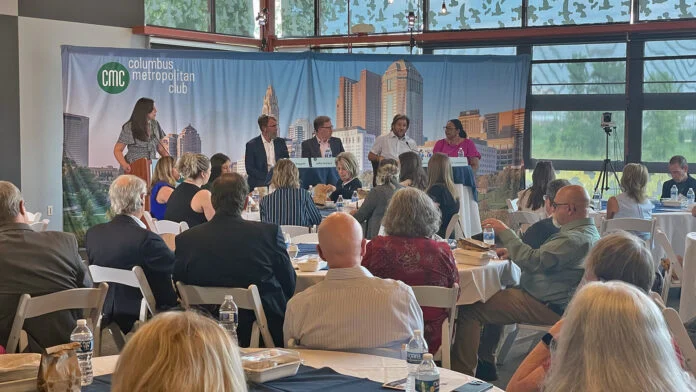Article by Tim Feran, originally posted on Columbus Underground
When the pandemic hit, some restaurant owners gave up the ghost. Others didn’t give up, but opened ghost kitchens.
It wasn’t spooky, just smart business — as a panel of experts in the delivery-only restaurant segment remarked in the Columbus Metropolitan Club forum: “Ghost Kitchens, Virtual Restaurants & Delivery Apps: How Tech is Disrupting Dining.”
The Club’s August 16 forum examined how restaurant operators were forced to get creative in order to survive the pandemic, and have created an entirely new segment of the business.
“I love the term ‘ghost kitchen,’” said panelist John Barker, President and CEO of The Ohio Restaurant Association. “Is that the Buxton Inn in Granville?”
After the audience laughter died down, Barker noted that “these brands really took off” during the pandemic, and “they saved a lot of marriages,” allowing couples to have a dinner date during a time when almost no one could go out of the house.
Definitions vary, but typically “ghost kitchens” are delivery-only brands that work out of a commercial kitchen space, while “virtual restaurants” are simply part of traditional, brick-and-mortar restaurants.
When the pandemic hit, “we already were in a commissary kitchen,” said Lisa A. Gutierrez, Founder and CEO of Dos Hermanos Taco Truck. So it was not too hard to switch gears into a slightly different model. More importantly, “we realized we were in a food desert.” Areas that Dos Hermanos had served pre-pandemic were left without good options for fresh food, and the Taco Truck “went from profit-driven to service-driven,” she said. In its own unique way, the ghost kitchen of Dos Hermanos didn’t just “save marriages, but saved a neighborhood.”
The community has responded to her service. In 2022, Dos Hermanos delivered 700 orders per week. The business now delivers 2,700 orders per week. Today, Dos Hermanos Columbus has venues at Lower.com Field, the Greater Convention Center and has locations at North Market Downtown, North Market Bridge Park and a restaurant at Easton Town Center.
“Food trucks come and go, so congratulations on your success,” said panelist Chris Baggott to Gutierrez. Baggott is Co-Founder and CEO of ClusterTruck, a “Digitally Native Virtual Restaurant” that is a delivery-only restaurant with everything in one system — “From click, to cook, to curb, you can track your order with ease using our app or website.”
Still, the ghost kitchen concept didn’t develop without a few bumps along the way.
“People like Chuck E. Cheese gave the industry a black eye,” said Bennett Goldberg, Partner at Maker Kitchens, which offers private, permitted commercial kitchens for pickup and delivery-only restaurants.
Goldberg was referring to a story that happened in 2020, said forum moderator Susan Post, Associate Editor of Columbus Underground.
“Pasqually’s Pizza turned out to be Chuck E. Cheese,” Post said. During the pandemic, while most of its typical customers were sequestered in their homes, Chuck E. Cheese began operating a delivery-only pizza brand out of its restaurants’ kitchens — and promoted it as Pasqually’s Pizza, quietly understating that it was actually Chuck E. Cheese pizza.
While restaurants work to overcome such hiccups, “we’re in a major evolution in the business,” Barker said. A large issue in that evolution is the cost of delivery. “Delivery services say they’re not making money, the drivers are not making money, and restaurants are still paying. We’re seeing pizza shops going back to their own delivery. It’s a real big issue. I hear people say, ‘I’m going to stop delivery,’ and I said, ‘Good luck.’”
“There’s no way for DoorDash to make money except through fees,” Baggott said. “The whole thing just doesn’t work. It comes down to jobs per hour.” While a DoorDash driver might get one delivery an hour, “I can get drivers a minimum of four jobs per hour.”
“Uber toggles back and forth, delivering food, delivering people,” Barker mused.
But that isn’t a good solution either, Baggott argued. “I always ask,” when riding in an Uber if the driver delivers both food and people, “but there isn’t much crossover. Food delivery is the worst job in the gig economy.”
Even as sitdown restaurants are rebuilding their clientele, delivery-only businesses continue to come on line, Post noted. “With so many options, have we hit a saturation point?”
“I hope not,” Barker said. “But it puts tremendous pressure on businesses.” He sees a segmenting of the market, with sitdown restaurants starting to rebuild business as people crave the experience of fine dining with a fully staffed establishment. Meanwhile, “the other segment is serving customers who just want ‘fuel,’ a lot of food — and cheap. My son is 25, he’s in that category.”
“Delivery is a category to itself (now),” Baggott said. “So a purpose-built business is going to win.”
Perhaps so, but Gutierrez remarked that “we learned a lot of lessons during the pandemic.” For instance, offering pickup or delivery “depends on the location.” Dos Hermanos’ location at the North Market Downtown serves its customers in a different way from the Bridge Park location, she said.
Barker agreed. “Large companies — usually fast or fast-casual (restaurants) — are pushing to a digital model. But others still want the experience. It really depends on the segment.”
The best advice for those who still want to get into the business?
“Diversify, diversify, diversify,” Gutierrez said. “We have food trucks, stalls at the North Market and Bridge Park and a full restaurant at Easton…”
“And keep that break-even as low as possible,” Baggott said.

